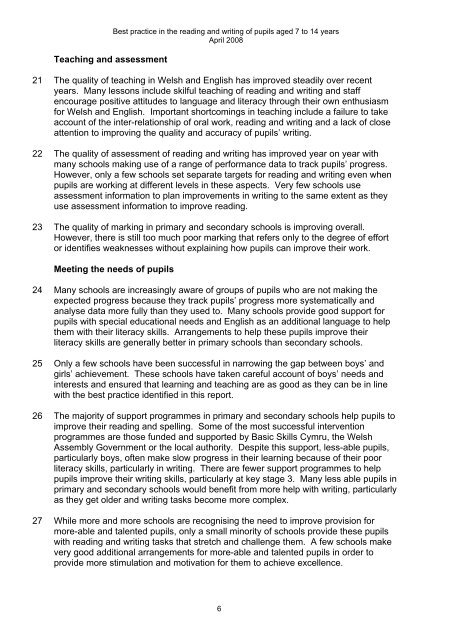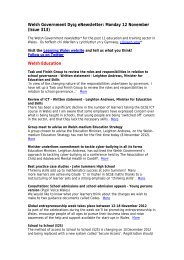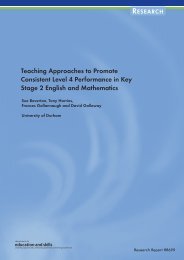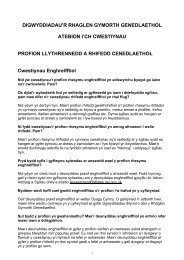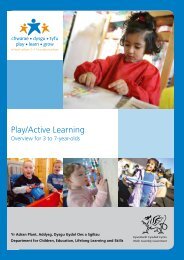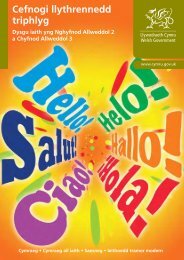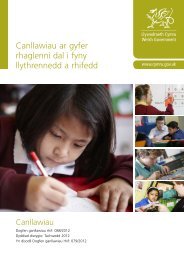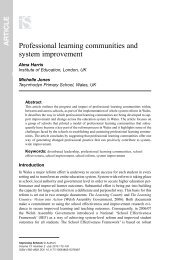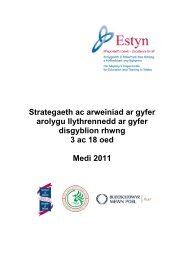Best practice in the reading and writing of pupils aged 7 to 14 ... - Estyn
Best practice in the reading and writing of pupils aged 7 to 14 ... - Estyn
Best practice in the reading and writing of pupils aged 7 to 14 ... - Estyn
You also want an ePaper? Increase the reach of your titles
YUMPU automatically turns print PDFs into web optimized ePapers that Google loves.
Teach<strong>in</strong>g <strong>and</strong> assessment<strong>Best</strong> <strong>practice</strong> <strong>in</strong> <strong>the</strong> read<strong>in</strong>g <strong>and</strong> writ<strong>in</strong>g <strong>of</strong> <strong>pupils</strong> <strong>aged</strong> 7 <strong>to</strong> <strong>14</strong> yearsApril 200821 The quality <strong>of</strong> teach<strong>in</strong>g <strong>in</strong> Welsh <strong>and</strong> English has improved steadily over recentyears. Many lessons <strong>in</strong>clude skilful teach<strong>in</strong>g <strong>of</strong> read<strong>in</strong>g <strong>and</strong> writ<strong>in</strong>g <strong>and</strong> staffencourage positive attitudes <strong>to</strong> language <strong>and</strong> literacy through <strong>the</strong>ir own enthusiasmfor Welsh <strong>and</strong> English. Important shortcom<strong>in</strong>gs <strong>in</strong> teach<strong>in</strong>g <strong>in</strong>clude a failure <strong>to</strong> takeaccount <strong>of</strong> <strong>the</strong> <strong>in</strong>ter-relationship <strong>of</strong> oral work, read<strong>in</strong>g <strong>and</strong> writ<strong>in</strong>g <strong>and</strong> a lack <strong>of</strong> closeattention <strong>to</strong> improv<strong>in</strong>g <strong>the</strong> quality <strong>and</strong> accuracy <strong>of</strong> <strong>pupils</strong>’ writ<strong>in</strong>g.22 The quality <strong>of</strong> assessment <strong>of</strong> read<strong>in</strong>g <strong>and</strong> writ<strong>in</strong>g has improved year on year withmany schools mak<strong>in</strong>g use <strong>of</strong> a range <strong>of</strong> performance data <strong>to</strong> track <strong>pupils</strong>’ progress.However, only a few schools set separate targets for read<strong>in</strong>g <strong>and</strong> writ<strong>in</strong>g even when<strong>pupils</strong> are work<strong>in</strong>g at different levels <strong>in</strong> <strong>the</strong>se aspects. Very few schools useassessment <strong>in</strong>formation <strong>to</strong> plan improvements <strong>in</strong> writ<strong>in</strong>g <strong>to</strong> <strong>the</strong> same extent as <strong>the</strong>yuse assessment <strong>in</strong>formation <strong>to</strong> improve read<strong>in</strong>g.23 The quality <strong>of</strong> mark<strong>in</strong>g <strong>in</strong> primary <strong>and</strong> secondary schools is improv<strong>in</strong>g overall.However, <strong>the</strong>re is still <strong>to</strong>o much poor mark<strong>in</strong>g that refers only <strong>to</strong> <strong>the</strong> degree <strong>of</strong> effor<strong>to</strong>r identifies weaknesses without expla<strong>in</strong><strong>in</strong>g how <strong>pupils</strong> can improve <strong>the</strong>ir work.Meet<strong>in</strong>g <strong>the</strong> needs <strong>of</strong> <strong>pupils</strong>24 Many schools are <strong>in</strong>creas<strong>in</strong>gly aware <strong>of</strong> groups <strong>of</strong> <strong>pupils</strong> who are not mak<strong>in</strong>g <strong>the</strong>expected progress because <strong>the</strong>y track <strong>pupils</strong>’ progress more systematically <strong>and</strong>analyse data more fully than <strong>the</strong>y used <strong>to</strong>. Many schools provide good support for<strong>pupils</strong> with special educational needs <strong>and</strong> English as an additional language <strong>to</strong> help<strong>the</strong>m with <strong>the</strong>ir literacy skills. Arrangements <strong>to</strong> help <strong>the</strong>se <strong>pupils</strong> improve <strong>the</strong>irliteracy skills are generally better <strong>in</strong> primary schools than secondary schools.25 Only a few schools have been successful <strong>in</strong> narrow<strong>in</strong>g <strong>the</strong> gap between boys’ <strong>and</strong>girls’ achievement. These schools have taken careful account <strong>of</strong> boys’ needs <strong>and</strong><strong>in</strong>terests <strong>and</strong> ensured that learn<strong>in</strong>g <strong>and</strong> teach<strong>in</strong>g are as good as <strong>the</strong>y can be <strong>in</strong> l<strong>in</strong>ewith <strong>the</strong> best <strong>practice</strong> identified <strong>in</strong> this report.26 The majority <strong>of</strong> support programmes <strong>in</strong> primary <strong>and</strong> secondary schools help <strong>pupils</strong> <strong>to</strong>improve <strong>the</strong>ir read<strong>in</strong>g <strong>and</strong> spell<strong>in</strong>g. Some <strong>of</strong> <strong>the</strong> most successful <strong>in</strong>terventionprogrammes are those funded <strong>and</strong> supported by Basic Skills Cymru, <strong>the</strong> WelshAssembly Government or <strong>the</strong> local authority. Despite this support, less-able <strong>pupils</strong>,particularly boys, <strong>of</strong>ten make slow progress <strong>in</strong> <strong>the</strong>ir learn<strong>in</strong>g because <strong>of</strong> <strong>the</strong>ir poorliteracy skills, particularly <strong>in</strong> writ<strong>in</strong>g. There are fewer support programmes <strong>to</strong> help<strong>pupils</strong> improve <strong>the</strong>ir writ<strong>in</strong>g skills, particularly at key stage 3. Many less able <strong>pupils</strong> <strong>in</strong>primary <strong>and</strong> secondary schools would benefit from more help with writ<strong>in</strong>g, particularlyas <strong>the</strong>y get older <strong>and</strong> writ<strong>in</strong>g tasks become more complex.27 While more <strong>and</strong> more schools are recognis<strong>in</strong>g <strong>the</strong> need <strong>to</strong> improve provision formore-able <strong>and</strong> talented <strong>pupils</strong>, only a small m<strong>in</strong>ority <strong>of</strong> schools provide <strong>the</strong>se <strong>pupils</strong>with read<strong>in</strong>g <strong>and</strong> writ<strong>in</strong>g tasks that stretch <strong>and</strong> challenge <strong>the</strong>m. A few schools makevery good additional arrangements for more-able <strong>and</strong> talented <strong>pupils</strong> <strong>in</strong> order <strong>to</strong>provide more stimulation <strong>and</strong> motivation for <strong>the</strong>m <strong>to</strong> achieve excellence.6


